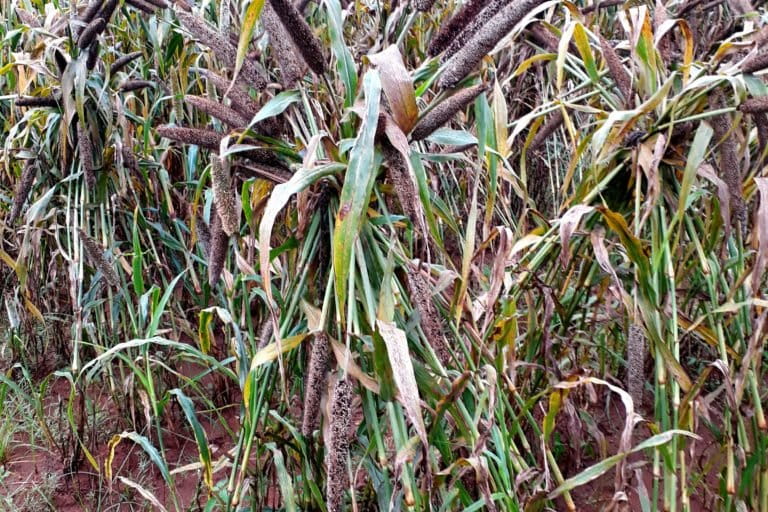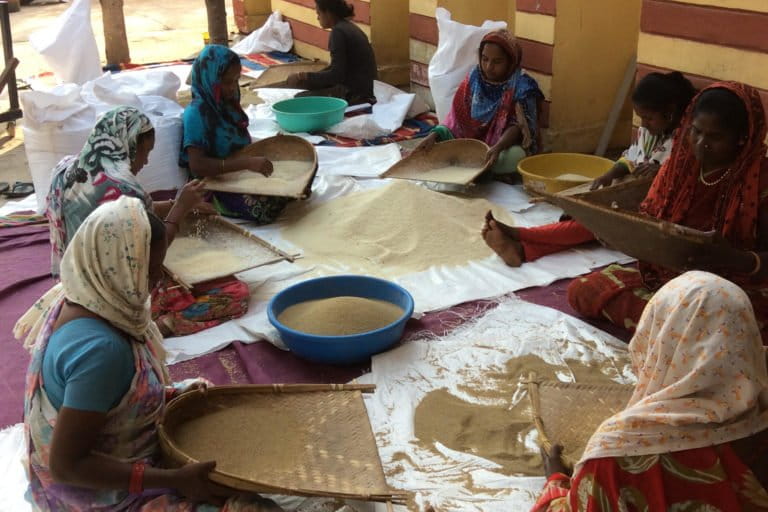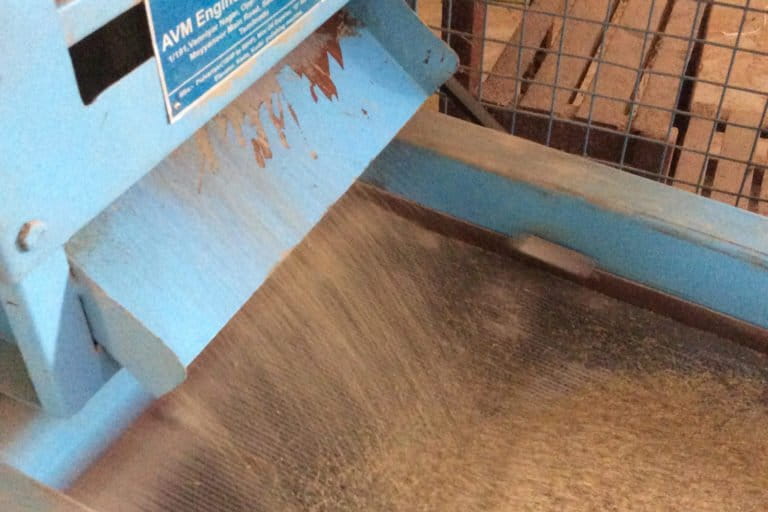
Featured image: Somnath Masal, a millet farmer in his field in Jamkhed, Maharashtra in India, on November 28, 2011. Photo: Abhijit Bhatlekar/Flickr, CC BY 2.0
The year 2023 will be observed as the International Year of Millets, following India’s proposal to the Food and Agriculture Organization, which was approved in at the 160th session of the FAO Council in December 2018. Through decades, the country has enjoyed a rich association with millets, though the Green Revolution favoured rice and wheat. Millets survived, thanks to cultural traditions, but came to be known as “coarse grains.”
Today, millets are returning to farms and fields as a result of national and state-level initiatives. Termed as nutri-cereals, millets are finding favour among farmers for being climate-smart crops that are drought resistant, growing in areas with low rainfall and infertile soil.
According to Shailaja Fennell, a lecturer at Jesus College in the University of Cambridge, millets are found in diverse parts of the world and form the earliest family of cereals cultivated by humans. “What is exciting about them is their genetic diversity. They have a huge potential for meeting our food needs in the future,” she said. But the erasure of traditional methods of farming by modern systems of biological classification has resulted in the marginalisation of tribals, she explained to Mongabay-India.

Vilas Tonapi, director of the Indian Institute of Millets Research (IIMR) agrees. “In the drylands, monocultures have driven farmers to bankruptcy. There is a need to go back to our culture of multi, mixed and intercropping as it provides insurance against monsoonal failure and also enables sustainable livelihoods,” he said.
Millets are suitable for harsh, hot and dry environments. They can grow in arid regions, requiring only 350-400 mm of annual rainfall. Some varieties of pearl millet survive at temperatures up to 46 degrees Celsius. Besides, they require minimal inputs, Tonapi added.
Also read: How Millets Can Make India’s Food Basket More Climate-Resilient
“In order to ensure that soil health is retained, we should focus on growing less extractive crops like millets. They are good for holding water and adding a lot of organic matter for soil health revival,” explained Raman Ahuja, a food and agriculture value chain specialist.
Millet production in India
In the past six decades, India has witnessed a decrease in the area under millets. However, the productivity (yield in kg/ha) of these crops has gone up due to the adoption of high-yielding varieties and improved production technologies.
Among the states, during 2017-18, the maximum area under millets was in Rajasthan, followed by Maharashtra and Karnataka.
The main reasons behind the decline are low remuneration, lack of input subsidies and price incentives, subsidised supply of fine cereals through the public distribution system (PDS) and change in consumer preferences, added Tonapi. These factors led to a shift from the production of millets (jowar in particular) to soybean, maize, cotton, sugarcane and sunflower.

“Generation of demand for millets-based products, along with productivity enhancement, will help farmers in realising better prices. Since the processing of millets involves hardships, proper processing and value additions will be effective in creating more demand among consumers,” said Tonapi.
India’s millet mission
India is the largest producer of millets in the world. The Centre declared 2018 as the year of millets. The country launched a campaign to promote these nutri-cereals across India on September 28 of that year.
The Government of India’s Millet Mission comes under the National Food Security Mission (NFSM), launched in October 2007. NFSM-Coarse Cereals is divided into two parts and one of them is the sub-mission on nutri cereals to be implemented in 202 districts of 14 states. Before this, millets were being promoted under INSIMP (Nutritional Security through Intensive Millets Promotion) during 2011-12 to 2013-14.
Also read: In the Year of Millets, Coarse Grains Remain Neglected Despite Nutritional Benefits
Currently, millets are being promoted through technology dissemination, quality seeds through millet seed hubs, awareness generation, minimum support price and inclusion in PDS.
But millets are still expensive. In the villages, minor millets are vanishing due to the predominance of ragi (finger millet). According to Jacob Nellithanam, who works with tribal farmers across India, the focus is on ragi as it is economically viable, increases soil fertility and can be intercropped.
Sanyasi Rao, programme manager at Wassan, a Telangana-based organisation which works on rainfed agriculture, pointed out that the supply chain of other millets seeds is inefficient, and there is a need to work on ensuring their availability.
“Unfortunately, IIMR is not in a position to supply seeds of other millets and so, obviously farmers use whatever seeds available,” Rao told Mongabay-India. “Also, seed subsidy is available to farmers only on released or certified seeds,” he added.
“As part of the millets mission, there are no restrictions to promote a particular crop. But ragi is getting popularity due to its easy processing facility and community adaptability,” Rao pointed out.
So, in a way, we are again entering into another kind of monoculture and risking our agro-biodiversity.

State-level millet missions
According to Srijit Mishra, director of Nabakrushna Choudhury Centre for Development Studies based in Bhubaneswar, the Odisha Millets Mission (OMM) has been facilitating production, processing, marketing and consumption of all millets.
Debjeet, who works with Kondh tribals in Odisha, said that millets have always been a part of the cropping system. Tribals practice mixed cropping and grow different varieties of millets as well as pigeon pea, cowpea, niger, turmeric and sesame, he added.
“All these crops have different durations. Some are deep rooted whereas others are shallow rooted. It is a complex arrangement. Each crop also has a ritual attached to it. Festivals bring communities together and reinforce the sense of belonging to a collective space. When we delink spiritual, cultural and ecological dimensions and bring productivity into the framework, it becomes a linear arrangement,” he explained.
According to Debjeet, the focus of the OMM is mainly on three millets: foxtail millet, finger millet or ragi and barnyard millet. However, a state government official said on the condition of anonymity that it is mostly ragi (more than 80%), under the mission because of people’s acceptance. “They are accustomed to its taste,” he said over phone when asked why the emphasis is mostly on ragi.

Under the current scenario, there is no denying the dominance of ragi under the OMM. An official associated with the Odisha agriculture department said 94,692 quintals of ragi was procured from 20,325 farmers at minimum support price in the 2019 Kharif season. For this, Rs 29.20 crore has been credited to the registered accounts of these farmers. Another official also agreed that ragi seed is available easily. In other millets, quality seeds are not available. But they will expand other millets cultivation as well, he said.
The focus on promotion of certain varieties of crops due to market demand worries Debjeet, who pointed out that monoculture will not help solve the zero hunger challenge. He hopes that experts associated with OMM possibly create some space where they listen to community elders and their world views.
The Madhya Pradesh government, on the other hand, is promoting kodo and kutki at the cost of other millets, said Naresh Biswas, who runs the non-profit Nirman in Dindori district of Madhya Pradesh.
The Andhra millets programme started in February 2016 and at present covers Srikakulam, Vizianagaram, Visakhapatnam, East Godavari, Anantapur, Chittoor and Kurnool districts, a total of 30,351 hectares (ha). Wassan’s Rao said there are efforts to practice intercropping with pulses and vegetables for diversification in Andhra Pradesh.
Also read: The Journey of the Humble Millet From Tribal Farms to Dinner Tables
“In Andhra, 1,300 acres are under guli ragi out of 15,000 acres under millets in the tribal belt, from East Godavari to Srikakulam. Out of 1,300 acres, polycropping is happening on 100 acres,” he said.
Rao said in Andhra, participatory varietal trials were conducted in six districts to explore local millets diversity. Varieties like pedda sama (little millet), banda korra (foxtail millet), pedda uda (barnyard millet) and pedda chodi (ragi) were found as promising.
Wassan has also established a millet processing facility at Mamidipalem village in Visakhapatnam. This unit is able to process 400 tonnes per year and is motivating farmers to grow other millets as well, he said.
Telangana launched a mini mission on millets in 2018 for a period of five years in six districts. The four main components of the project are promotion, consumption, processing and marketing of millets.

According to Ahuja, the approach to millets needs to reflect on the importance of local land races. Missions should allow for partnerships with local grassroots organisations to build a sustained momentum for revival of millets production, he explained.
“There needs to be a strong integration of the sub-mission on nutri cereals with the flagship Poshan Abhiyaan of the Union government. The focus on revival of millets should be complimented by the revival of consumption by producers. This will have long-term benefits in reduction of malnutrition,” said Ahuja.
Problems on ground
Fennell pointed out that there is considerable knowledge of the value of little millets among traditional communities. In the south, little millets such as thinai (foxtail millet) are popular both in the villages as well as in trendy eateries.
But she added that apart from ragi and jowar, other types of millets have tough seed coats and need more processing. “While little millets are difficult to process, this does not imply that they will be lost,” she explained. There should be more focus on the modification of current processing machines to ensure the conversion of millet seeds into flour.
“There are current innovation centres in numerous institutions that are designing appropriate processors. These initiatives need to be scaled up and made available at reasonable prices to farmers to ensure that little millets can be produced commercially,” Fennell said.
Dwiji Guru of the Millet Foundation said millet processing has to be diversified. Processing centres should be able to process other grains as well. To sustain multicropping, multi-processing units should be enabled at the same place.
Also Read: Indian Farmers Are Building Food Forests to Fight Climate Change, Agrarian Crisis
Fennell said traditional varieties of millets cultivated in semi-arid conditions, and which do not use irrigation, are resistant to pest infestations. However, if there is a move to creation of improved varieties that have higher sugar or carbohydrate levels largely as a consequence of irrigating millets to increase yields, locusts may become attracted to the plants, she added. Thus, there is a need to ensure that only semi-arid methods rather than irrigated cultivation ones are promoted.
The way forward
Israel Oliver King, director in charge, regional centre, MS Swaminathan Research Foundation prescribes a balanced approach where there will be local specific farming as well as agriculture based on market demands.
“There are millet hotspots like Mandla and Dindori in Madhya Pradesh, Malkangiri in Odisha, the Garhwal Himlayas and Kolli hills in Tamil Nadu. These locations should be promoted for diverse-centric agriculture. Diversity is the hope in today’s world, as it is not only about food, but also about soil, bees and pollination,” he explained.
The promotion of ragi in Odisha, ragi and jowar in Karanataka and kodo and kutki in Madhya Pradesh need not be at the cost small millets, Tonapi said. “There should be a parallel policy of promoting small millets along with major millets in domestic and international markets.”
This article was originally published on Mongabay.

